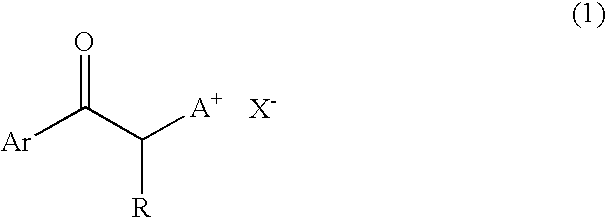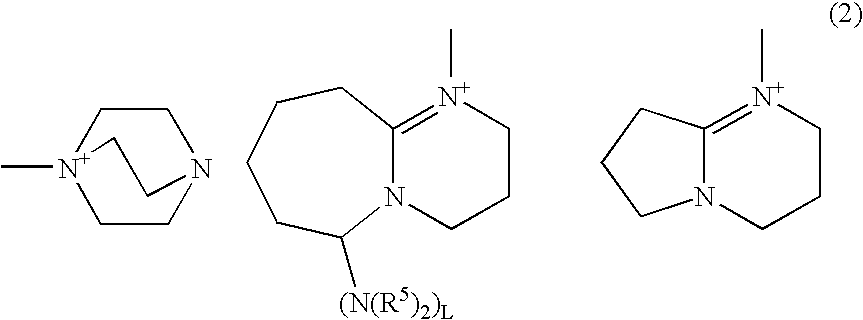Photocurable composition and coating composition
a composition and composition technology, applied in the field of photocurable compositions and coating compositions, can solve the problems of low productivity, limited application, and short history of photo-base generator studies, and base generators capable of exhibiting a practicable activity have not been found until now
- Summary
- Abstract
- Description
- Claims
- Application Information
AI Technical Summary
Benefits of technology
Problems solved by technology
Method used
Image
Examples
example 1
[0056] One hundred parts by weight of bis(β-epithiopropyl)sulfide, 2 parts by weight of 1-phenacyl-(1-azonia-4-azabicyclo[2.2.2]-octane)tetraphenyl borate (PnDbBP4), 3 parts by weight of γ-butyrolactone and 0.1 part by weight of a silicone oil “KF-351” available from Shin-Etsu Chemical Co., Ltd., were intimately mixed with each other to obtain a uniform solution. Then, the thus obtained solution was deaerated under a reduced pressure of 10 Torr for 10 min, and further filtered through a 0.5 μm-mesh PTFE filter. The thus treated solution was applied onto a glass substrate using a bar coater (No. 9) to form a coating film.
[0057] The thus coated glass substrate was placed in a box with a quartz window, and a nitrogen gas was flowed through the box. After it was confirmed that an oxygen concentration in the box reached 0.2% or lower, the coating film was irradiated with ultraviolet rays for 4 min using a metal halide lamp (30 mW / cm2; 365 nm). Thereafter, the obtained cured product were...
examples 2 to 7
[0062] The same procedure as in Example 1 was repeated except that the conditions for production of the cured product were changed as shown in Table 1. The results are shown in Table 1.
example 8
[0063] One hundred parts by weight of bis(β-epithiopropyl)sulfide, 2 parts by weight of 1-phenacyl-(1-azonia-4-azabicyclo[2.2.2]-octane)tetraphenyl borate (PnDbBP4), 6 parts by weight of γ-butyrolactone and 0.1 part by weight of a silicone oil “KF-351” available from Shin-Etsu Chemical Co., Ltd., were intimately mixed with each other to obtain a uniform solution. The thus obtained solution was deaerated under a reduced pressure of 10 Torr for 10 min, and further filtered through a 0.5 μm-mesh PTFE filter. After one droplet of the thus treated solution was dropped onto a glass substrate, the glass substrate was covered with a stretched polypropylene film, and the solution dropped was spread over the glass substrate while discharging air from a space between the film and the substrate.
[0064] The coated glass substrate covered with the polypropylene film was irradiated with ultraviolet rays for 2 min using a metal halide lamp (30 mW / cm2; 365 nm). Thereafter, the obtained cured coating...
PUM
| Property | Measurement | Unit |
|---|---|---|
| refractive index | aaaaa | aaaaa |
| temperature | aaaaa | aaaaa |
| temperature | aaaaa | aaaaa |
Abstract
Description
Claims
Application Information
 Login to View More
Login to View More - R&D
- Intellectual Property
- Life Sciences
- Materials
- Tech Scout
- Unparalleled Data Quality
- Higher Quality Content
- 60% Fewer Hallucinations
Browse by: Latest US Patents, China's latest patents, Technical Efficacy Thesaurus, Application Domain, Technology Topic, Popular Technical Reports.
© 2025 PatSnap. All rights reserved.Legal|Privacy policy|Modern Slavery Act Transparency Statement|Sitemap|About US| Contact US: help@patsnap.com



